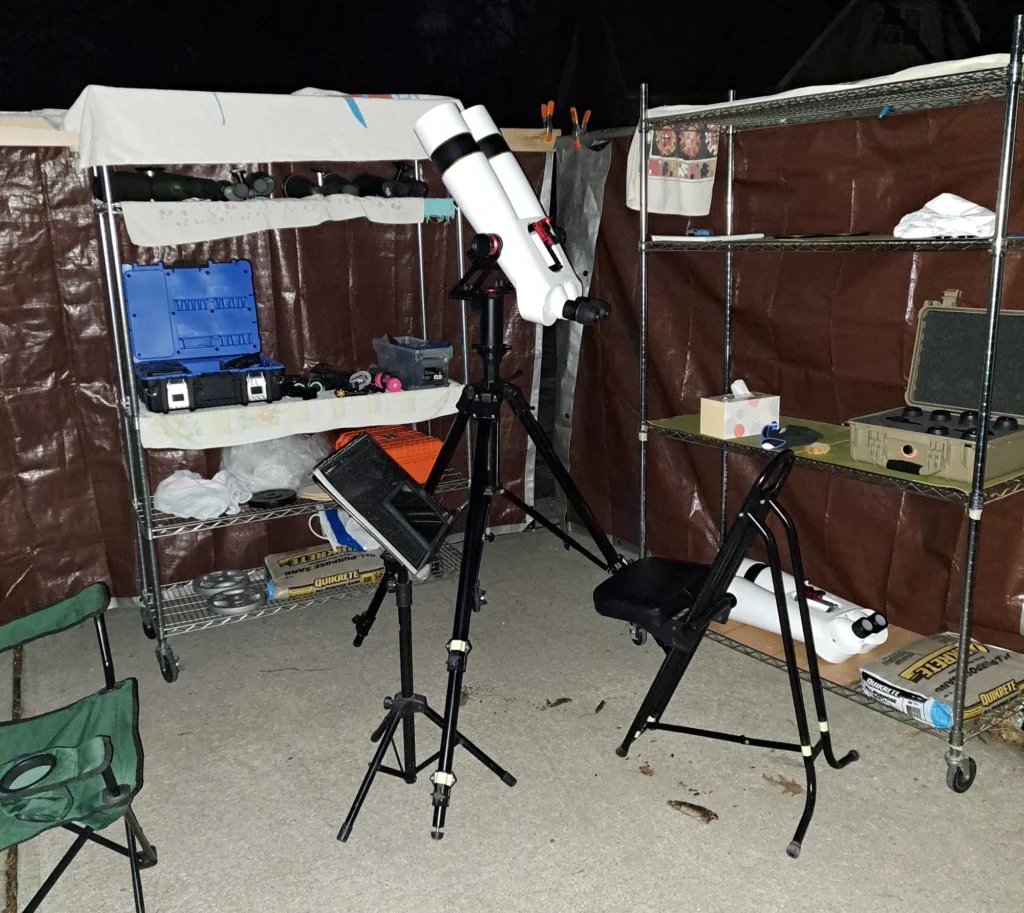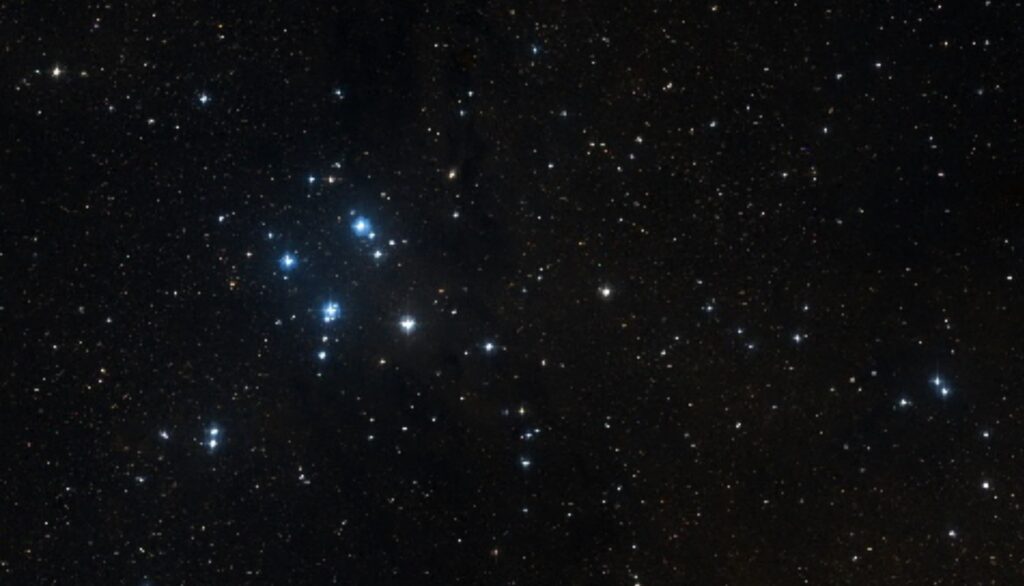Camelopardalis is a giraffe, not a camel, but the title is too amusing to resist, so I’m going with it. And because inquiring minds want to know, it is said to be pronounced kuh-mel-uh–pahr-dl-is by dictionary.com, but cam-el-oh-par-dal-iss has a more musical ring to my ear so that is how I say it, without much fear of correction when it comes up in conversation. 😉
So what makes it so cruel? From his comment on the Comet ZTF post, star hopping across it with the small FOV of a telescope to find the obscure galaxy UGC 3697, the Integral Sign Galaxy, because the constellation is such a wide expanse of dim stars. Kudos to columbidae for having accomplished that, BTW. No mean star hopping feat. He goes on to remark that binoculars are easier to navigate the constellation, particularly if they are mounted. Indeed.
Not that it would be possible to observe a 12th magnitude galaxy with binoculars or even binocular telescopes, apart from a few custom made behemoths, but there is still plenty to observe and enjoy with binoculars in this neglected constellation, and finding one’s way around it with generous binocular fields of view is an enjoyable pastime compared to the rigors of navigating it with a telescope.

The above image is from my mobile driveway observatory (courtesy of Costco rolling shelf units configured as light shields with inexpensive tarps) taken on Friday, 17 February 2023. Shown mounted is the prototype of the Oberwerk 120XL-SD, a new addition to Oberwerk’s XL binocular telescope line, the first shipment of which is anticipated in April. The instrument on the shelving unit is Oberwerk’s flagship 127XL-SD binocular telescope. The 120 offers performance similar to the 127XL at lower cost and weight.
My plan on the 17th was to revisit Stock 23 and NGC 1502 with the larger BTs, but I found the constellation enough to the west that they were obscured by the dreaded “Pines of Rome” bordering my driveway, so my center of operations was rolled to the end of the driveway, where thankfully they were still in view. As bulky as they are, either BT mounted on the Manfrotto 161MK2B with an Oberwerk XL-280 fork can be carried without undue effort, so moving the setup took only a few minutes. The skies were reasonably transparent with no moon. I somehow did not take an SQM-L meter reading (but would guess it would have been about 18.0 mpsas — magnitude per square arc second).
Stock 23
This cluster is a treat viewed with larger binocular telescopes like the 127XL or 120XL, both of which have sufficient aperture to highlight the four main stars in the cluster and bring out many fainter members . Two of the brighter stars are part of a graceful arc of five stars, which includes the double star STF 362, splendid at (46-47x – 14mm XWs) in this pleasing starfield, along with two additional pairs of stars across the Cassiopeia border, one of which is DAM 655. Many additional stars add interest to the grouping. For example, the line of three stars extending away from STF 362.

STF 362
03h16m +60*02′
8.31/8.60 7.1″ pa 143*
Both stars white. Slight magnitude difference seen. Really fun to have finally observed this. It should also be readily seen with the 82XL, honestly. Hmm. Noticed C and D components while reviewing data, at 10.5 and 12.59 magnitude, both of which should be observable with the 127XL or 120XL at higher magnification. Something to look for on my next visit.
DAM 655
03h15m +60*41′
9.20/9.30 46.8″ pa 129*
A physical double star, shown to the far right in the above image. The pair of seemingly unrelated stars below Stock 23 on the left side of the image is not listed in the Washington Double Stars catalog — HD 237090 (V803) and HD 237091. (Discoverer code of Frank L. Damm, PhD Ohio State University, 1970.)
Tom 5
120XL+14XWs
Although I was unable to see this with the 82XL on February 12th, it was visible with both the 120 and 120XL this evening as a faint moderately sized glow in averted with a few stars resolved, but definitely seen. And fun. Need to try this from a darker site.
NGC 1502
Another outstanding view with the larger BTs, as anticipated a great deep sky object in suburban skies. What the larger aperture accomplishes is to bring out many additional cluster members in a compressed grouping around the double star STF 485, data for which was provided in the previous Camelopardalis post. Not recounted in that post or this is a second double star, STF 484, which is close to the first. The cluster is said to form a rough arrow head, which is pointing to the north west as described by Ted Aranda in his monolithic catalog 3,000 Deep-Sky Objects, observed with a home-made binocular telescope built with two 10-inch Cassegrain optical tube assemblies. In an appendix to the catalog, Aranda provides detailed information about how to construct such an instrument. 😊 Glancing over the 7 pages Stephen O’Meara devotes to Kemble’s Cascade and NGC 1502 (Hidden Treasures catalog entries 21 and 23 in his Deep-Sky Companions series), it occurs to me that I could devote much more time to this cluster.
M67
Perhaps my most enchanting view of the evening, made with the 120XL – I had set the 127XL aside and moved closer to the garage after wrapping up my adventures in Camelopardalis. I could see many cluster members resolved west and south of HD 75700 which is a bright yellowish star within the cluster boundary, but at half the distance (1376 LY vs 2600 for M67) not a true cluster member. I want to review the O’Meara description of this object.


Camelopardalis and Monoceros both have great things to offer and both get ignored by me far too often. I believe it comes down to their dim stars, location amongst bright big name targets, and probably a big reason for myself is their funny sounding names that I have a hard time saying…. Nobody wants to give directions to an object inside a constellation they can’t pronounce 😆
Monoceros is to the south, so I have a smaller window for observing it because of neighboring trees south of my yard. This is the time of year for a visit, Astro. I’ll review my observations from last year and come up with an itinerary. Thanks for mentioning this constellation. 100% agreed about it being neglected, and also about the possible reasons why. 😏